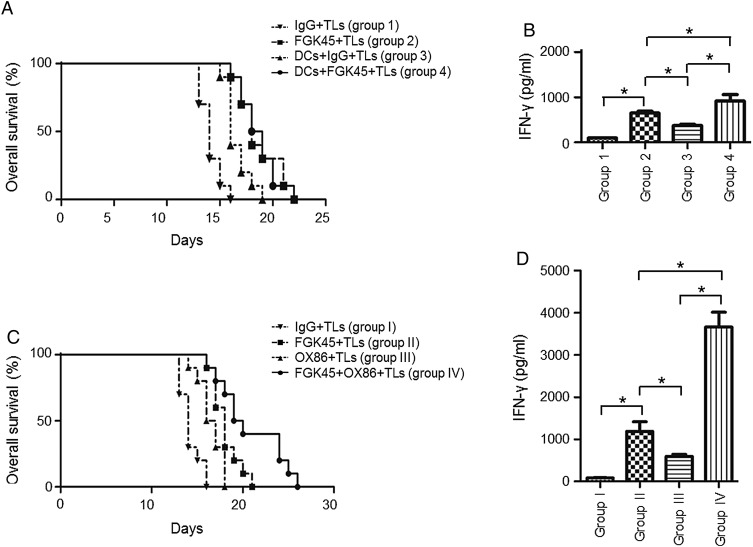Fig. 4.
Effects of the combined immunotherapy of FGK45, DCs, and OX86 in the GIC model mouse. (A) Survival analysis of NSCL61-model mice treated with an s.c. injection of irradiated NSCL61 cells as TLs and IgG (group 1), TLs and FGK45 (group 2), TLs, DCs, and IgG (group 3), and TLs, DCs, and FGK45 (group 4). FGK45 therapy (group 2), DC therapy (group 3), and combination therapy (group 4) significantly prolonged survival compared with group 1 (P < .0001, P = .0001, P < .0001). The synergistic effects of the combination therapy (group 4) were detected compared with DC therapy alone (group 3; P = .0083), while not detected compared with FGK45 therapy alone (group 2; P = .8559). (B) Production of the IFN-γ protein by mouse CD4-positive T cells after the second s.c. vaccination as determined by ELISA. Comparisons among groups 1, 2, 3, and 4. Bars indicate the mean ± SD. (C) Survival analysis of NSCL61-model mice treated with an s.c. injection of irradiated NSCL61 cells as TLs and IgG (group I), TLs and FGK45 (group II), TLs and OX86 (group III), and TLs, OX86, and FGK45 (group IV). FGK45 therapy (group II), OX86 therapy (group III), and combination therapy (group IV) significantly prolonged survival compared with group I (P = .0001, P = .0013, P < .0001). Synergistic effects of the combination therapy (group IV) were detected compared with FGK45 therapy alone (group II; P = .0382) and OX86 therapy alone (group III; P = .0313). (D) Production of the IFN-γ protein by mouse CD4-positive T cells after the second s.c.vaccination as determined by ELISA. Comparisons among groups I, II, III, and IV. Bars indicate the mean ± SD.

